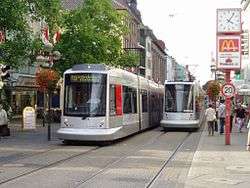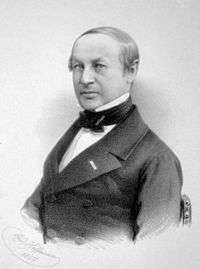Neuss
Neuss (German pronunciation: [ˈnɔʏs] (![]()
Neuss | |
|---|---|
Town hall | |
 Coat of arms | |
Location of Neuss within Rhein-Kreis Neuss district  | |
 Neuss  Neuss | |
| Coordinates: 51°12′N 6°42′E | |
| Country | Germany |
| State | North Rhine-Westphalia |
| Admin. region | Düsseldorf |
| District | Rhein-Kreis Neuss |
| Government | |
| • Mayor | Reiner Breuer (SPD) |
| Area | |
| • Total | 99.48 km2 (38.41 sq mi) |
| Elevation | 40 m (130 ft) |
| Population (2018-12-31)[1] | |
| • Total | 153,796 |
| • Density | 1,500/km2 (4,000/sq mi) |
| Time zone | CET/CEST (UTC+1/+2) |
| Postal codes | 41460-41472 |
| Dialling codes | 02131, 02137 (Norf), 02182 |
| Vehicle registration | NE, GV |
| Website | www.neuss.de |
History

Ancient Rome
Neuss was founded by the Romans in 16 BC as a military fortification (castrum) with the current city to the north of the castrum, at the confluence of the rivers Rhine and Erft, with the name of Novaesium.
Legio XVI Gallica ("Gallic 16th Legion") of the Roman army was stationed here in 43-70 AD. It was disbanded after surrendering during the Batavian rebellion (AD 70).[2]
Later a civil settlement was founded in the area of today's centre of the town during the 1st century AD. Novaesium, together with Trier (Augusta Treverorum), is one of the three oldest Roman settlements in Germany.
Middle Ages
Neuss grew during the Middle Ages because of its prime location on several routes, by the crossing of the great Rhine valley, and with its harbour and ferry. During the 10th century, the remains of the martyr and tribune Saint Quirinus, not to be confused with the Roman god Quirinus, had been relocated to Neuss. This resulted in pilgrimage to the shrine of St. Quirinus even from countries beyond the borders of the Holy Roman Empire. Neuss was first documented as a town in 1138.
One of the main events in the town's history is the siege of the town in 1474–75 by Charles the Bold, Duke of Burgundy, that lasted for nearly a year. The citizens of Neuss withstood the siege and were therefore rewarded by the Holy Roman Emperor Frederick III. The town was granted the right to mint its own coins and to carry the imperial coat of arms, the imperial eagle and the crown, in the town's own coat of arms. Neuss became a member of the Hanseatic League, although it was never accepted by the other members of the League.
Early modernity
In 1586, more than two-thirds of the city was destroyed by fire, and several wars during the reign of King Louis XIV of France resulted in worsening finances for Neuss. Its importance as a place for trading declined rapidly, and from the mid-17th century onwards, Neuss became a place only important for its agriculture.
Until the late 18th century, Neuss belonged to the Electorate of Cologne. From 1794 to 1814, Neuss was part of France during the reign of Napoleon. In 1815 after the Napoleonic Wars, Neuss became part of the Kingdom of Prussia, and was reorganized as a district with the municipalities of Neuss, Dormagen, Nettesheim, Nievenheim, Rommerskirchen and Zons. The town had a population of 6,333 at that time. It was part of the Prussian Province of Jülich-Cleves-Berg (1815–22) and its successor, the Rhine Province (1822–1946).
19th century – present
Neuss regained its economic power in the 19th century, with expansion of the harbour in 1835, and increasing industrial activity. The city's boundaries were expanded in 1881. Neuss became part of the new state of North Rhine-Westphalia in 1946.
In 1968 the spelling of the name was changed from Neuß to Neuss. In 1975 the town of Neuss and the district of Grevenbroich were joined to form the district of Rhein-Kreis Neuss with a population of 440,000 and its seat of government in Neuss. Neuss is also home to Toshiba's European headquarters.
| Largest groups of foreign residents[3] | |
| Nationality | Population (2018) |
|---|---|
| 5,440 | |
| 1,775 | |
| 1,627 | |
| 1,132 | |
| 1,088 | |
| 1,072 | |
| 982 | |
| 829 | |
Mayors and Lord Mayors since 1849
- 1849–1851: Heinrich Thywissen, Mayor (Bürgermeister)
- 1851–1858: Michael Frings, Mayor
- 1858–1882: Johann Joseph Ridder, Mayor
- 1882–1889: Carl Wenders, Mayor
- 1890–1902: Engelbert Tilmann, Mayor
- 1902–1921: Franz Gielen, Lord Mayor
- 1921–1930: Heinrich Hüpper, Lord Mayor
- 1930–1934: Wilhelm Henrichs, Centre Party, Lord Mayor (Oberbürgermeister)
- 1934–1938: Wilhelm Eberhard Gelberg, NSDAP, Lord Mayor
- 1938–1945: Wilhelm Tödtmann, NSDAP, Lord Mayor
- 1945–1946: Josef Nagel, Lord Mayor
- 1946: Josef Schmitz, Lord Mayor
- 1946–1961: Alfons Frings, CDU, Lord Mayor
- 1961–1967: Peter Wilhelm Kallen, Lord Mayor
- 1967–1982: Herbert Karrenberg, CDU, Lord Mayor
- 1982–1987: Hermann Wilhelm Thywissen, CDU, Lord Mayor
- 1987–1998: Bertold Mathias Reinartz, CDU, Mayor
- 1998–2015: Herbert Napp, CDU, Mayor
- 2015–present: Reiner Breuer, SPD, Mayor
Number of inhabitants
- 1798: 4,423
- 1831: 7,888
- 1861: 10,300
- 1885: 20,074
- 1900: 28,472
- 1925: 44,958
- 1945: 51,624
- 1965: 111,104
- 1987: 142,178
- 2015: 159,672
Sports
One sports club is Neusser Schlittschuh-Klub. Their sections are figure skating, ice stock sport and, as the only club in Germany, bandy. With the lack of a large ice surface, the variety rink bandy is practiced.[4] There are also two football clubs in the city of Neuss, VfR Neuss Football Club, and DJK Novesia Neuss. There is also a fieldhockey club, HTC Schwarz-Weiss Neuss, and TC Blau-Weiss Neuss, a famous tennis club where Nadal began his career. And an American Football Club, the Neuss Frogs. Besides Neuss owns an all-weather racecourse called "Galopprennbahn Neuss".
Points of interest
- Botanischer Garten der Stadt Neuss, the city's botanical garden
- Basilica of St. Quirinus: a 13th-century late romanesque church, dedicated to the city's patron saint and housing a shrine with his relics. Its dome-shaped eastern tower is one of the city's landmarks. In 2009 it was granted the title of minor basilica.
- Obertor (Upper Gate): southern city gate, built circa 1200; today part of the Clemens Sels Museum Neuss. It is the only remaining of originally six gates that were part of the medieval town fortification.
- Blutturm (Bloody Tower): built in the 13th century, the only remaining round tower of the historic town fortification.
- Zum "Schwatte Päd" (The Black Horse): the oldest public house in the Lower Rhine region, established 1604
- Saint Sebastianus Church
- Saint Maria Church:
- Christuskirche (Christ church): historicistic church, the city's oldest Protestant church
- Globe Theater, a replica of the London Globe Theatre, with an annual Shakespeare festival
- Hamtor/the Hamgate
- Neusser Bürger-Schützenfest: one of Germany's largest marksmen's festivals, taking place annually on the last weekend in August; roundabout 7000 marksmen take part in the traditional parades.
Notable people

- Hildegund (virgin) (1170–1188), saint
- Johann Pennarius (1517–1563), auxiliary bishop in Cologne
- Hermann Thyraeus (1532–1591), theologian and member of the Society of Jesus
- Peter Thyraeus, (1546–1601) Jesuit, professor of theology in Würzburg
- Theodor Schwann (1810–1882), physiologist
- Franz Maria Feldhaus (1874–1957), technical historian and scientific writer
- Joseph Frings (1887–1978), Archbishop of the Archbishopric of Cologne
- Kurt Josten (1912–1994), German-British jurist, state official and resistance fighter
- Erik Martin (1936–2017[5]), author, songwriter and editor
- Mario Ohoven (born 1946), financial intermediary and investment adviser
- Elke Aberle (born 1950), actress
- Mònica Oltra (born 1969) Spanish politician; currently vice president, spokesperson and minister for Equality and Inclusive Policies of the Valencian government.
- Friedhelm Funkel (born 1953), football player and coach
- Heike Hohlbein (born 1954), writer
- Jürgen P. Rabe (born 1955), physicist
- Norbert Hummelt (born 1962), writer
- Kai Böcking (born 1964), moderator
- Franziska Pigulla (1964–2019), German actress, news presenter and voice actress
- Thomas Rupprath (born 1977), swimmer
- Lars Börgeling (born 1979), pole vaulter
- Judith Flemig (born 1979), volleyball player
- Jared Karim (born 1979, lived here c. 1981–1992), German-born Bangladeshi-American entrepreneur and computer scientist; co-founder of YouTube
- Marcel Ohmann (born 1991), ice hockey player
- Danny da Costa (born 1993), footballer
Twin towns - sister cities





Gallery
 Saint Quirinus Minster
Saint Quirinus Minster- Obertor
 St. Sebastianus Church
St. Sebastianus Church- Christuskirche
 Blutturm
Blutturm
References
- "Bevölkerung der Gemeinden Nordrhein-Westfalens am 31. Dezember 2018" (in German). Landesbetrieb Information und Technik NRW. Retrieved 10 July 2019.
- Matthew Bunson (1 January 2009). Encyclopedia of the Roman Empire. Infobase Publishing. pp. 313–. ISBN 978-1-4381-1027-1.
- "Die ausländischen Mitbürger in der Stadt Neuss am 0 1.01.2013" (PDF). Stadt Neuss. Retrieved 2014-10-26.
- Neusser Schlittschuh-Klub official home page
External links
| Wikimedia Commons has media related to Neuss. |
- Official website

- . Encyclopædia Britannica (11th ed.). 1911.